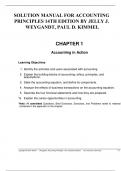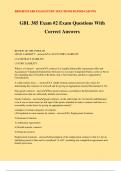SOLUTION MANUAL Full_
FOR ACCOUNTING
PRINCIPLES 14TH EDITION
Solution BYfor
Manual JELLY J.
WEYGANDT,
Accounting PAUL D.
Principles KIMMEL
14th Edition Jerry J.
Weygandt, Paul D. Kimmel, Jill E. Mitchell
With Appendix g,h
CHAPTER 1
Accounting in Action
Learning Objectives
1. Identify the activities and users associated with accounting.
2. Explain the building blocks of accounting: ethics, principles, and
assumptions.
3. State the accounting equation, and define its components.
4. Analyze the effects of business transactions on the accounting equation.
5. Describe the four financial statements and how they are prepared.
*6. Explain the career opportunities in accounting.
*Note: All asterisked Questions, Brief Exercises, Exercises, and Problems relate to material
contained in the appendix*to the chapter.
Copyright © 2021 WILEY Weygandt, Accounting Principles, 14/e, Solutions Manual (For Instructor Use Only) 1-1
, ANSWERS TO QUESTIONS
1. This is true. Virtually every organization and person in our society uses accounting information.
Businesses, investors, creditors, government agencies, and not-for-profit organizations must use
accounting information to operate effectively.
LO1 BT: C Difficulty: Easy TOT: 2 min. AACSB: None AICPA FC: Reporting
2. Accounting is the process of identifying, recording, and communicating the economic events of
an organization to interested users of the information. The first activity of the accounting process
is to identify economic events that are relevant to a particular business. Once identified and
measured, the events are recorded to provide a history of the financial activities of the
organization. Recording consists of keeping a chronological diary of these measured events in an
orderly and systematic manner. The information is communicated through the preparation and
distribution of accounting reports, the most common of which are called financial statements.
A vital element in the communication process is the accountant’s ability and responsibility to
analyze and interpret the reported information.
LO1 BT: C Difficulty: Easy TOT: 4 min. AACSB: None AICPA FC: Reporting
3. (a) Internal users are those who plan, organize, and run the business and therefore are officers
and other decision makers.
(b) To assist management, managerial accounting provides internal reports. Examples include
financial comparisons of operating alternatives, projections of income from new sales
campaigns, and forecasts of cash needs for the next year.
LO1 BT: C Difficulty: Easy TOT: 2 min. AACSB: None AICPA FC: Reporting
4. (a) Investors (owners) use accounting information to make decisions to buy, hold, or sell owner-
ship shares of a company.
(b) Creditors use accounting information to evaluate the risks of granting credit or lending money.
LO1 BT: C Difficulty: Easy TOT: 2 min. AACSB: None AICPA FC: Reporting
5. This is false. Bookkeeping usually involves only the recording of economic events and therefore is
just one part of the entire accounting process. Accounting, on the other hand, involves the entire
process of identifying, recording, and communicating economic events.
LO1 BT: C Difficulty: Easy TOT: 2 min. AACSB: None AICPA FC: Reporting
6. Benton Travel Agency should report the land at $90,000 on its December 31, 2022 balance
sheet. This is true not only at the time the land is purchased, but also over the time the land is
held. In determining which measurement principle to use (historical cost or fair value) companies
weigh the factual nature of cost figures versus the relevance of fair value. In general, companies
use historical cost. Only in situations where assets are actively traded do companies apply the
fair value principle.
LO2 BT: C Difficulty: Easy TOT: 4 min. AACSB: None AICPA FC: Reporting
7. The monetary unit assumption requires that only transaction data that can be expressed in terms
of money be included in the accounting records. This assumption enables accounting to quantify
(measure) economic events.
LO2 BT: K Difficulty: Easy TOT: 2 min. AACSB: None AICPA FC: Reporting
8. The economic entity assumption requires that the activities of the entity be kept separate and
distinct from the activities of its owners and all other economic entities.
LO2 BT: K Difficulty: Easy TOT: 2 min. AACSB: None AICPA FC: Reporting
1-2 Copyright © 2021 WILEY Weygandt, Accounting Principles, 14/e, Solutions Manual (For Instructor Use Only)
,Questions Chapter 1 (Continued)
9. The three basic forms of business organizations are: (1) proprietorship, (2) partnership, and
(3) corporation.
LO2 BT: K Difficulty: Easy TOT:1 min. AACSB: None AICPA FC: Reporting
10. One of the advantages Helen Rupp would enjoy is that ownership of a corporation is represented
by transferable shares of stock. This would allow Helen to raise money easily by selling a part of
her ownership in the company. Another advantage is that because holders of the shares
(stockholders) enjoy limited liability; they are not personally liable for the debts of the corporate
entity. Also, because ownership can be transferred without dissolving the corporation, the corporation
enjoys an unlimited life.
LO2 BT: K Difficulty: Easy TOT: 4 min. AACSB: None AICPA FC: Reporting
11. The basic accounting equation is Assets = Liabilities + Owner’s Equity.
LO3 BT: K Difficulty: Easy TOT: 1 min. AACSB: None AICPA FC: Measurement
12. (a) Assets are resources owned by a business. Liabilities are creditor claims against assets. Put
more simply, liabilities are existing debts and obligations. Owner’s equity is the ownership
claim on total assets.
(b) Owner’s equity is affected by owner’s investments, drawings, revenues, and expenses.
LO3 BT: C Difficulty: Easy TOT: 2 min. AACSB: None AICPA FC: Reporting
13. The liabilities are: (b) Accounts payable and (g) Salaries and wages payable.
LO3 BT: C Difficulty: Easy TOT: 1 min. AACSB: None AICPA FC: Reporting
14. Yes, a business can enter into a transaction in which only the left side of the accounting equation
is affected. An example would be a transaction where an increase in one asset is offset by a
decrease in another asset. An increase in the Equipment account which is offset by a decrease in
the Cash account is a specific example.
LO4 BT: C Difficulty: Moderate TOT: 3 min. AACSB: None AICPA FC: Reporting
15. Business transactions are the economic events of the enterprise recorded by accountants
because they affect the basic accounting equation.
(a) The death of the owner of the company is not a business transaction as it does not affect of
the components of the basic accounting equation.
(b) Supplies purchased on account is a business transaction as it affects the basic accounting
equation.
(c) An employee being fired is not a business transaction as it does not affect any of the
components of the basic accounting equation.
(d) A withdrawal of cash by the owner from the business is a business transaction as it affects the
basic accounting equation.
LO4 BT: C Difficulty: Moderate TOT: 4 min. AACSB: None AICPA FC: Reporting
16. (a) Decrease assets and decrease owner’s equity.
(b) Increase assets and decrease assets.
(c) Increase assets and increase owner’s equity.
(d) Decrease assets and decrease liabilities.
LO4 BT: C Difficulty: Moderate TOT: 3 min. AACSB: None AICPA FC: Reporting
Copyright © 2021 WILEY Weygandt, Accounting Principles, 14/e, Solutions Manual (For Instructor Use Only) 1-3
, Questions Chapter 1 (Continued)
17. (a) Income statement. (d) Balance sheet.
(b) Balance sheet. (e) Balance sheet and owner’s equity statement.
(c) Income statement. (f) Balance sheet.
LO5 BT: C Difficulty: Easy TOT: 2 min. AACSB: None AICPA FC: Reporting
18. No, this treatment is not proper. While the transaction does involve a receipt of cash, it does not
represent revenues. Revenues are the gross increase in owner’s equity resulting from business
activities entered into for the purpose of earning income. This transaction is simply an additional
investment made by the owner in the business; it increases Cash and Owner’s Capital.
LO4 BT: C Difficulty: Moderate TOT: 3 min. AACSB: None AICPA FC: Reporting
19. Yes. Net income does appear on the income statement—it is the result of subtracting expenses
from revenues. In addition, net income appears in the owner’s equity statement—it is shown as
an addition to the beginning-of-period capital. Indirectly, the net income of a company is also
included in the balance sheet. It is included in the end-of-period capital which appears in the
owner’s equity section of the balance sheet.
LO5 BT: C Difficulty: Moderate TOT: 4 min. AACSB: None AICPA FC: Reporting
20. (a) Ending capital balance ..................................................................................... $189,000
Less: Beginning capital balance ....................................................................... 186,000
Net income....................................................................................................... $ 3,000
($189,000 – $186,000 = $3,000)
(End. cap. bal. – Beg. cap. bal. = Net inc.)
(b) Ending capital balance ..................................................................................... $189,000
Less: Beginning capital balance ....................................................................... 186,000
Net increase in capital balance 3,000
Deduct: Investment ......................................................................................... 13,000
Net loss............................................................................................................ $ (10,000)
($189,000 – $186,000 – $13,000 = ($10,000))
(End. cap. bal. – Beg. cap. bal. – Invest. = Net. loss)
LO5 BT: AP Difficulty: Moderate TOT: 4 min. AACSB: Analytic AICPA FC: Reporting
21. (a) Total revenues ($20,000 + $70,000) ................................................................ $90,000
($20,000 + $70,000 = $90,000)
(Cash rev. + Rev. on acct. = Tot. rev.)
(b) Total expenses ($26,000 + $40,000) ................................................................ $66,000
($26,000 + $40,000 = $66,000)
(Cash exp. + Exp. on acct. = Tot. exp.)
(c) Total revenues ................................................................................................. $90,000
Total expenses................................................................................................. 66,000
Net income....................................................................................................... $24,000
($90,000 – $66,000 = $24,000)
(Tot. rev. – Tot. exp. = Net inc.)
LO5 BT: AP Difficulty: Moderate TOT: 4 min. AACSB: Analytic AICPA FC: Reporting
22. Apple’s accounting equation (in millions) at September 28, 2019 was $338,516 = $248,028 +
$90,488.
($338,516 = $248,028+ $90,488)
(Tot. assets = Tot. liabl. + Tot. stkhldrs. equity)
LO3 BT: AP Difficulty: Moderate TOT: 3 min. AACSB: Analytic AICPA FC: Reporting
1-4 Copyright © 2021 WILEY Weygandt, Accounting Principles, 14/e, Solutions Manual (For Instructor Use Only)





